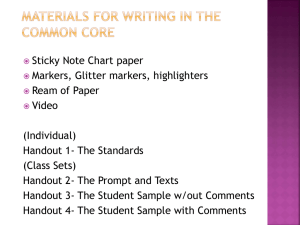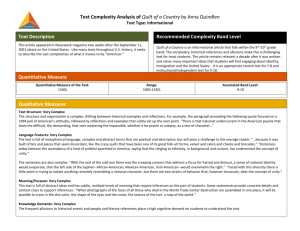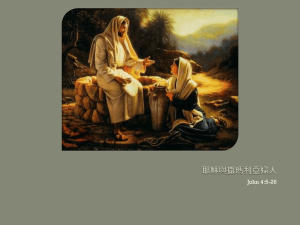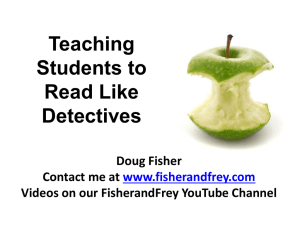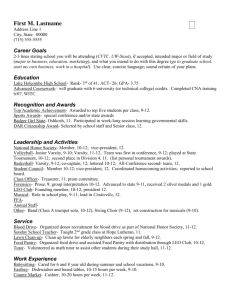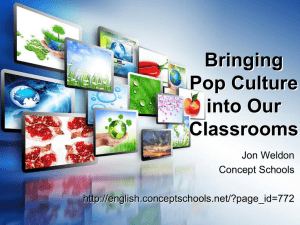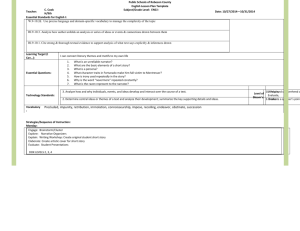Grades 9-12 ELA Curriculum Map
advertisement
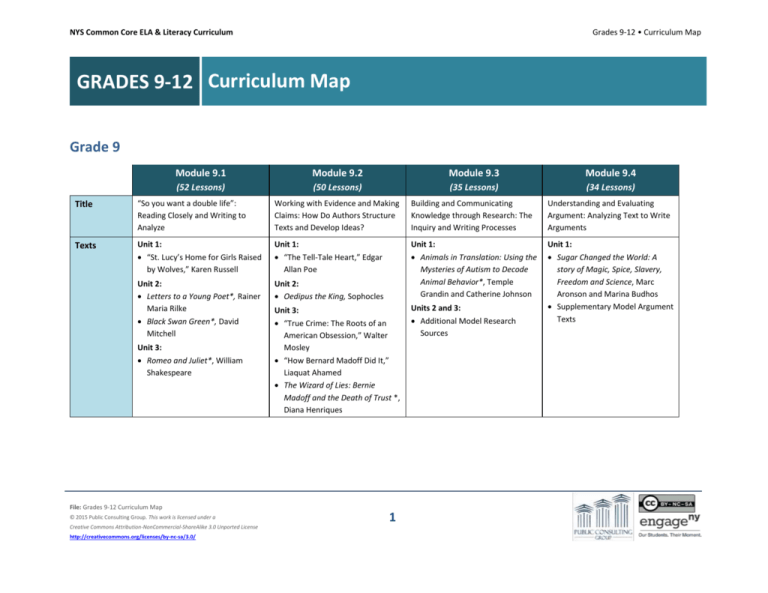
NYS Common Core ELA & Literacy Curriculum Grades 9-12 • Curriculum Map GRADES 9-12 Curriculum Map Grade 9 Module 9.1 Module 9.2 Module 9.3 Module 9.4 (52 Lessons) (50 Lessons) (35 Lessons) (34 Lessons) Title “So you want a double life”: Reading Closely and Writing to Analyze Working with Evidence and Making Claims: How Do Authors Structure Texts and Develop Ideas? Building and Communicating Knowledge through Research: The Inquiry and Writing Processes Understanding and Evaluating Argument: Analyzing Text to Write Arguments Texts Unit 1: “St. Lucy’s Home for Girls Raised by Wolves,” Karen Russell Unit 1: “The Tell-Tale Heart,” Edgar Allan Poe Unit 2: Letters to a Young Poet*, Rainer Maria Rilke Black Swan Green*, David Mitchell Unit 2: Oedipus the King, Sophocles Unit 1: Animals in Translation: Using the Mysteries of Autism to Decode Animal Behavior*, Temple Grandin and Catherine Johnson Unit 1: Sugar Changed the World: A story of Magic, Spice, Slavery, Freedom and Science, Marc Aronson and Marina Budhos Supplementary Model Argument Texts Unit 3: Romeo and Juliet*, William Shakespeare Unit 3: “True Crime: The Roots of an American Obsession,” Walter Mosley “How Bernard Madoff Did It,” Liaquat Ahamed The Wizard of Lies: Bernie Madoff and the Death of Trust *, Diana Henriques File: Grades 9-12 Curriculum Map © 2015 Public Consulting Group. This work is licensed under a Creative Commons Attribution-NonCommercial-ShareAlike 3.0 Unported License http://creativecommons.org/licenses/by-nc-sa/3.0/ 1 Units 2 and 3: Additional Model Research Sources NYS Common Core ELA & Literacy Curriculum Assessed Standards Addressed Standards Grades 9-12 • Curriculum Map CCRA.R.9 CCRA.R.6, 9 RI.9-10.1 (a), 2, 3, 5, 7 CCRA.R.9, RL.9-10.1, 2, 3, 4, 5, 7, 11 RL.9-10.2, 3, 4, 5, 11 W.9-10.2 (a-f), 4, 5, 6, 7, 8, 9 RI.9-10.2, 3, 4, 5, 6, 7, 8 RI.9-10.2, 3, 4 RI.9-10.2, 5 L.9-10.1, 2, 3 (a), 6 W.9-10.1 (a-e), 5 W.9-10.2 (a, c, f) W.9-10.2 (a-d, f), 5 SL.9-10.1 (b, c) SL.9-10.1 (a-d) L.9-10.5 (a) L.9-10.1, 2 SL.9-10.4 RI.9-10.7 SL.9-10.1 W.9-10.4, 9 (b) L.9-10.4 (a-c) W.9-10.9 (a, b) L.9-10.2 (a-c), 4 (a-d) SL.9-10.1 (c-d) L.9-10.1 (a-b), 2 (a-c), 5 SL.9-10.4, 6 L.9-10.3 (a), 4 (a-c), 6 L.9-10.4 (a, b), 5 (a, b) Performance Assessment Prompt Identify a specific phrase or central idea in paragraphs 4–9 of Rilke’s “Letter Seven.” Analyze how that phrase or central idea relates to one or more central ideas in “St. Lucy’s Home for Girls Raised by Wolves” or Romeo and Juliet. Identify a central idea shared by one literary text and one informational text. Use specific details to explain how this central idea develops over the course of each text, and compare how the authors’ choices about text structure contribute to the development of this idea. * Indicates excerpts File: Grades 9-12 Curriculum Map © 2015 Public Consulting Group. This work is licensed under a Creative Commons Attribution-NonCommercial-ShareAlike 3.0 Unported License http://creativecommons.org/licenses/by-nc-sa/3.0/ 2 Create a blog post using information from your research paper and various multimedia components to enhance your research findings. Update or enhance the information from your research paper by linking to other supporting information and displaying the information flexibly and dynamically. Make effective use of available multimedia components, including hyperlinks, images, graphics, animation, charts, graphs, video, and audio clips. For this assessment you must choose at least four of these texts and write a multi-paragraph argument essay in response to the following prompt: Is local food production an example of ethical consumption? Provide evidence from at least four sources in your response. NYS Common Core ELA & Literacy Curriculum Grades 9-12 • Curriculum Map Grade 10 Module 10.1 Module 10.2 Module 10.3 Module 10.4 (38 Lessons) (40 Lessons) (43 Lessons) (41 Lessons) Title Reading Closely and Writing to Analyze: How do Authors Develop Complex Characters and Ideas? “These are strange times, my dear.”: How do Authors Use Rhetoric and Word Choice to Develop Ideas and Claims? Researching Multiple Perspectives to Develop a Position “It is a Tale … Full of Sound and Fury”: How do authors use craft and structure to develop characters and ideas? Texts Unit 1: “The Passionate Shepherd to his Love,” Christopher Marlowe “The Nymph’s Reply to the Shepherd,” Sir Walter Raleigh “Raleigh Was Right,” William Carlos Williams Unit 1: “Letter from Birmingham Jail,” Martin Luther King, Jr. “In this Blind Alley,” Ahmad Shamlu “Freedom,” Rabindranath Tagore “Women,” Alice Walker Unit 1: The Immortal Life of Henrietta Lacks*, Rebecca Skloot Unit 1: “Death of a Pig,” E.B. White Unit 2: The Tragedy of Macbeth, William Shakespeare Unit 2: “The Palace Thief,” Ethan Canin Unit 3: The Joy Luck Club*, Amy Tan Friday Night Lights: A Town, a Team, and a Dream*, H.G. Bissinger Unit 2: “A Genetics of Justice,” Julia Alvarez “Remembering to Never Forget: Dominican Republic’s ‘Parsley Massacre,’” Mark Memmott Unit 3: Universal Declaration on Human Rights “On the Adoption of the Universal Declaration of Human Rights,” Eleanor Roosevelt “Address to the United Nations Youth Assembly,” Malala Yousafzai File: Grades 9-12 Curriculum Map © 2015 Public Consulting Group. This work is licensed under a Creative Commons Attribution-NonCommercial-ShareAlike 3.0 Unported License http://creativecommons.org/licenses/by-nc-sa/3.0/ 3 Units 2 and 3: Additional Model Research Sources Unit 3: The Prince*, Niccolo Machiavelli NYS Common Core ELA & Literacy Curriculum Assessed Standards Grades 9-12 • Curriculum Map CCRA.R.6, 9 RL.9-10.2, 4 RI.9-10.1 (a), 2, 3, 4, 5, 6, 8 RL.9-10.2, 3, 4, 5, 7 (a), 9, 11 RL.9-10.2, 3, 4, 5, 9, 11 RI.9-10.2, 3, 4, 5, 6, 7, 8 W.9-10.2 (a-f), 9 (b) W.9-10.1 (a-e), 2 (b, d, e), 4, 5, 7, 9 (b) RI.9-10.2, 4, 5, 6 RI.9-10.2, 3, 6 L.9-10.1, 2, 5 SL.9-10.4, 5, 6 SL.9-10.1 (a-e), 4 L.9-10.1, 2, 3 (a), 6 L.9-10.1 (a, b), 2 (a-c) W.9-10.2 (a, b, d, f), 4, 9 (a, b) SL.9-10.1 (a) W.9-10.1 (a-e), 2 (a-f), 5, 9 (a, b) L.9-10.1, 2 (c) Addressed Standards Performance Assessment Prompt RL.9-10.1 RL.9-10.6 SL.9-10.1 (a, c) SL.9-10.6 RI.9-10.1 RI.9-10.9 L.9-10.1 (a), 2 (a-c), 4 (a, c, d) 5 (a) L.9-10.3 (a), 4 (a-c), 5 (a, b) W.9-10.2 (c) W.9-10.5, 9 (a) SL.9-10.1 (c-e) SL.9-10.1 (a-e) L.9-10.1 (a, b), 2 a), 3, 4 (a), 5 (a), 6 L.9-10.1 (a), 2 (a), 4 (a, b), 5 (a) Draw upon your analysis of two of the 10.1 texts in order to respond to the following prompt: Identify a purpose common to King’s “Letter from Birmingham Jail,” Alvarez’s “A Genetics of Justice,” and one of the texts from 10.2.3. Discuss how each of these texts uses at least one of the following to advance that purpose: structure, rhetoric, or impact of specific word choices. Build on the analysis you did for your research-based argument paper by producing a five-minute podcast. Synthesize your research and offer salient points of the research in an engaging oral presentation that demonstrates command of formal spoken English. Your podcast should detail your central claim, two supporting claims with relevant and sufficient evidence, and one counterclaim with corresponding limitations (rebuttals). Further, your podcast should present information, findings, and supporting evidence clearly, concisely, and logically such that listeners can follow your line of reasoning. Select a central idea common to Macbeth and either White’s “Death of a Pig” or Machiavelli’s The Prince. Discuss how each author uses structure, character, word choice, and/or rhetoric to develop this common idea. Explain the nuances in each author’s treatment of the idea. How do the two narrators’ different points of view impact the development of a common central idea? * Indicates excerpts File: Grades 9-12 Curriculum Map © 2015 Public Consulting Group. This work is licensed under a Creative Commons Attribution-NonCommercial-ShareAlike 3.0 Unported License http://creativecommons.org/licenses/by-nc-sa/3.0/ 4 NYS Common Core ELA & Literacy Curriculum Grades 9-12 • Curriculum Map Grade 11 Module 11.1 Module 11.2 Module 11.3 Module 11.4 (42 Lessons) (42 Lessons) (42 Lessons) (42 Lessons) Title “O, what a noble mind is here o’erthrown!”: How do authors develop and relate elements of a text? “There is within and without the sound of conflict”: How do authors use figurative language or rhetoric to advance a point of view or purpose? Researching Multiple Perspectives to Develop a Position “This is one story I’ve never told before.”: How do authors use narrative techniques to craft fiction writing? Texts Unit 1: “My Last Duchess,” Robert Browning Unit 1: The Souls of Black Folks*, W.E.B. Du Bois “Atlanta Compromise Speech,” Booker T. Washington Unit 1: “Hope, Despair and Memory,” Elie Wiesel Unit 1: The Things they Carried*, Tim O’Brien The Red Convertible: Selected and New Stories*, Louise Erdrich Unit 2: Hamlet*, William Shakespeare Unit 3: A Room of One’s Own*, Virginia Woolf Assessed Standards Unit 2: “An Address by Elizabeth Cady Stanton” “From the House of Yemanja,” Audre Lorde Performance Assessment: “How to Write the Great American Indian Novel,” Sherman Alexie Units 2 and 3: Additional Model Research Sources Unit 2: The Awakening, Kate Chopin CCRA.R.9 CCRA.R.8, 9 CCRA.R.8 RL.11-12.2, 3, 4, 5, 6, 11 RL.11-12.2, 3, 4, 5, 6, 11 RL.11-12.2, 4 RI.11-12.1 (a), 2, 6 W.11-12.2 (a-f), 3 (a-e), 4, 5, 9 (a) RI.11-12.2, 3, 6 RI.11-12.2, 3, 4, 6 SL.11-12.1 (a, c, d) W.11-12.2 (a-f), 9 (a, b) W.11-12.2 (a-f), 5 W.11-12.1 (a-e), 2 (a, b, d, e, f), 4, 5, 7, 8, 9 (b) SL.11-12.1 (a-e) SL.11-12.1 (a, c) SL.11-12.1 (d), 3, 4, 5, 6 L.11-12.1, 2, 5 L.11-12.1, 2, 5 (a) L.11-12.1, 2, 3 File: Grades 9-12 Curriculum Map © 2015 Public Consulting Group. This work is licensed under a Creative Commons Attribution-NonCommercial-ShareAlike 3.0 Unported License http://creativecommons.org/licenses/by-nc-sa/3.0/ 5 L.11-12.1, 2 NYS Common Core ELA & Literacy Curriculum Addressed Standards Performance Assessment Prompt Grades 9-12 • Curriculum Map RI.11-12.1, 9 (a) W.11-12.4, 9 (a, b) SL.11-12.1 (c) W.11-12.6, 7 W.11-12.5 SL.11-12.3 L.11-12.3 (a), 4 (a, b) L.11-12.1 (a, b), 2 (a, b) 3 (a), 4 (ad), 5 (a), 6 L.11-12.4 (a, b), 5 L.11-12.4 (a-d), 5 (a, b) Select a central idea common to all three texts. How do the authors develop this idea over the course of each text? How do the texts work together to build your understanding of this central idea? Develop and present a claim about how Sherman Alexie’s poem “How to Write the Great American Indian Novel” relates to central ideas and/or points of view developed in at least two of the four texts in this module. Support your claim with evidence and reasoning. Build on the analysis you did for your research-based argument paper by producing a three- to fiveminute video presentation. Distill and reorganize your research for a specific audience and offer essential points of the research in an engaging video presentation that demonstrates command of content and uses formal spoken English. Your presentation should make strategic use of the video format to enhance and add interest to your research findings. The presentation should also state your central claim, two supporting claims with relevant and sufficient evidence, and one counterclaim with corresponding limitations. Further, your video should also present information, findings, and supporting evidence clearly, concisely, and logically such that listeners can follow your line of reasoning. For this assessment, craft a 1–3 page narrative writing piece in response to the following prompt: * Indicates excerpts File: Grades 9-12 Curriculum Map © 2015 Public Consulting Group. This work is licensed under a Creative Commons Attribution-NonCommercial-ShareAlike 3.0 Unported License http://creativecommons.org/licenses/by-nc-sa/3.0/ 6 Write an original narrative piece that assumes a specific point of view based on the setting of “On the Rainy River,” “The Red Convertible,” or The Awakening. Choose two narrative writing substandards (W.11-12.3.a-e) and develop the criteria of both substandards in your narrative writing piece. NYS Common Core ELA & Literacy Curriculum Grades 9-12 • Curriculum Map Grade 12 Module 12.1 Module 12.2 Module 12.3 Module 12.4 (43 Lessons) (41 Lessons) (41 Lessons) (42 Lessons) Title “All of our experiences fuse into our personality. Everything that ever happened to us is an ingredient.”: Reading and Writing Personal Narratives “I ask for, not at once no government, but at once a better government.”: Exploring Complex Ideas through Craft and Structure Researching Multiple Perspectives to Develop a Position “I continually find myself in the ruins/ of new beginnings”: Analyzing the Interaction of Central Ideas and Character Development Texts Unit 1: The Autobiography of Malcolm X, as told to Alex Haley Unit 2: “Yellow Woman and a Beauty of the Spirit,” Leslie Marmon Silko Unit 1: “Ideas Live On,” Benazir Bhutto “Civil Disobedience,” Henry David Thoreau Unit 2: The Tragedy of Julius Caesar, William Shakespeare Unit 1: Guns, Germs, and Steel*, Jared Diamond Additional Model Research Sources Unit 2: Additional Model Research Sources Unit 1: Assessed Standards A Streetcar Named Desire, Tennessee Williams “A Daily Joy to Be Alive,” Jimmy Santiago Baca Unit 2: “The Overcoat,” Nikolai Gogol The Namesake, Jhumpa Lahiri RI.11-12.2, 3, 4, 5, 6 CCRA.R.8, 9 CCRA.R.8 CCRA.R.9 W.11-12.2 (a-f), 3 (a-f), 4, 5, 9 (b) RL.11-12.2, 3, 4, 5, 6, 11 RI.11-12.1 (a), 3, 6 RL.11-12.2, 3, 4, 5, 7, 11 SL.11-12.4, 6 RI.11-12.2, 3, 6 L.11-12.1, 2 (a-b), 4 (a-c) W.11-12.2 (a-f), 9 (a-b) W.11-12.1 (a-e), 2 (a-f), 4, 5, 7, 8, 9 SL.11-12.1 (d), 4, 5, 6 W.11-12.1 (d, e), 2 (a-f), 3 (a-e), 4, 9 (a) SL.11-12.1 (a-c), 4, 6 L.11-12.1, 2, 3 SL.11-12.1 (a, c, d) L.11-12.1, 2 L.11-12.1, 2 (a-b), 5 (a) File: Grades 9-12 Curriculum Map © 2015 Public Consulting Group. This work is licensed under a Creative Commons Attribution-NonCommercial-ShareAlike 3.0 Unported License http://creativecommons.org/licenses/by-nc-sa/3.0/ 7 NYS Common Core ELA & Literacy Curriculum Addressed Standards Grades 9-12 • Curriculum Map RI.11-12.1 CCRA.R.6 W.11-12.9 (b) W.11-12.6 SL.11-12.1 (b) SL.11-12.1 (a, c), 3 SL.11-12.1 (a-c) L.11-12.4 (a-c), 5 (b) L.11-12.1 (b), 2 (a, b), 3 (a), 4 (a, c) 6 For this assessment, draw upon your analysis of the three 12.2 texts in order to write a multiparagraph response to one of the following prompts: Build on your research and analysis by crafting a single 5–10 minute multimedia narrative that conveys how your research process led you to your findings. Using relevant excerpts from the multimedia journal entries you completed over the course of this module, your final product should depict cohesively the evolution of your research. Your final product should present a cohesive story of the research process that led you to your final central claim, and should therefore include your final central claim, several supporting claims, reasoning, and evidence. The final product should draw clear connections between early research and the final claims, as this project documents that development. Edit, delete, paste together, and add voiceover, interviews, and effects where appropriate in order to achieve this goal. L.11-12.3, 5 (a) Performance Assessment Prompt Work in peer groups to practice responding orally to a series of questions that colleges may ask during an interview, and assess your peers on several aspects of their answers including the organization, development, substance, and style of their responses. Also, take your peers’ feedback into account to prepare for the culminating assessment: a fishbowl activity in which students respond orally to one of the questions you have practiced and are assessed on their response. Is democracy “the last improvement possible in government” (Thoreau, part 3, par. 19)? What is the role and responsibility of government? Who should have the power to make decisions in a society? L.11-12.4 (a, b), 5 (a), 6 Choose from one of the two writing assessment options below. Option #1: Narrative + Informative Writing: This is a two-part writing assessment. Part A. Choose a key scene or critical moment from one of the module texts. Rewrite the key scene or critical moment so that the character(s) make a different choice than the one made in the actual text. Choose whichever genre (play or story) best fits the scene. The scene should have a narrative arc and the content should remain consistent with the original texts. Part B. After drafting the narrative, write a commentary on how the narrative choices you made shape or re-shape the character’s identity and explain how your choices impact the original text. Option #2: Argument + Narrative Writing: This is a two-part writing assessment. Part A. Select 1-2 of the module texts and make an evidence-based File: Grades 9-12 Curriculum Map © 2015 Public Consulting Group. This work is licensed under a Creative Commons Attribution-NonCommercial-ShareAlike 3.0 Unported License http://creativecommons.org/licenses/by-nc-sa/3.0/ 8 NYS Common Core ELA & Literacy Curriculum Grades 9-12 • Curriculum Map claim about the role of place or culture in creating an identity. Discuss the role of place or culture in creating an identity using textual evidence for support. Part B. Write a 1-2 page personal narrative about the influence of place or culture on your identity. Ground your narrative in a quote from one of the module texts or an experience of one of the characters. * Indicates excerpts File: Grades 9-12 Curriculum Map © 2015 Public Consulting Group. This work is licensed under a Creative Commons Attribution-NonCommercial-ShareAlike 3.0 Unported License http://creativecommons.org/licenses/by-nc-sa/3.0/ 9

